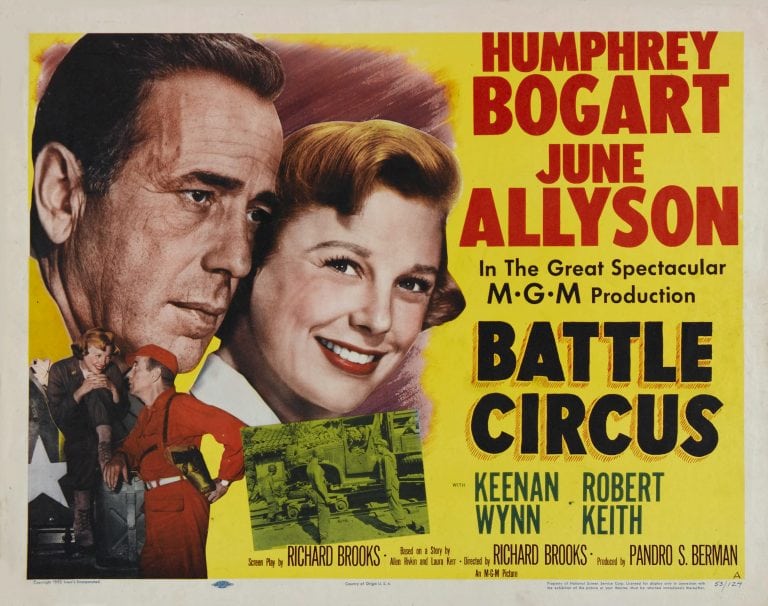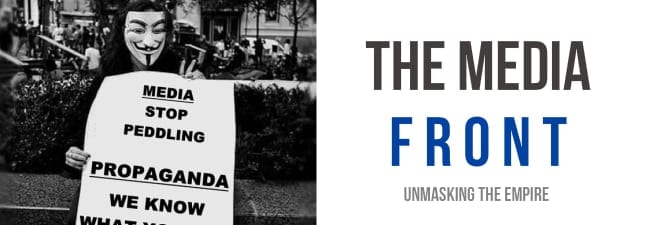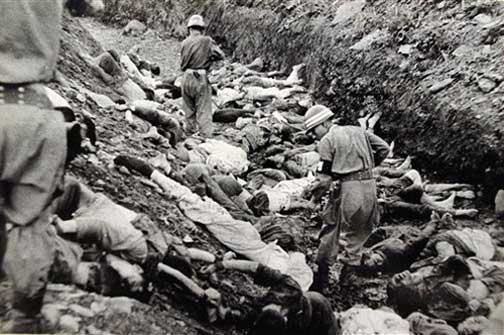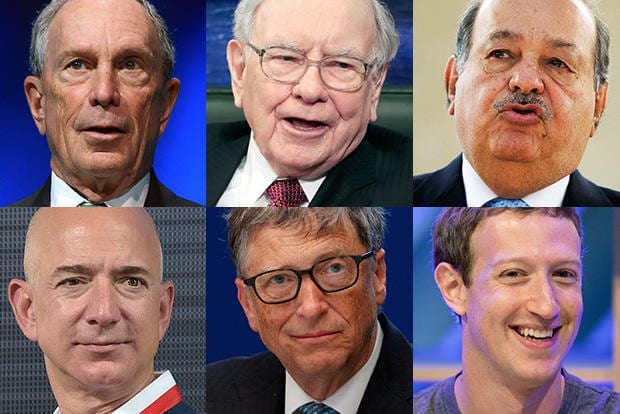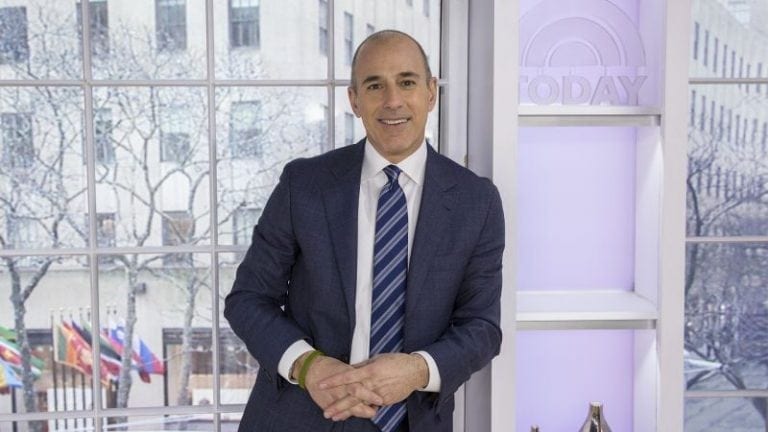HOW HOLLYWOOD SOLD US THE (GOOD) KOREAN WAR
PROPAGANDA AS ENTERTAINMENT AN OLD AND POWERFUL TOOL IN MANAGING PUBLIC OPINION
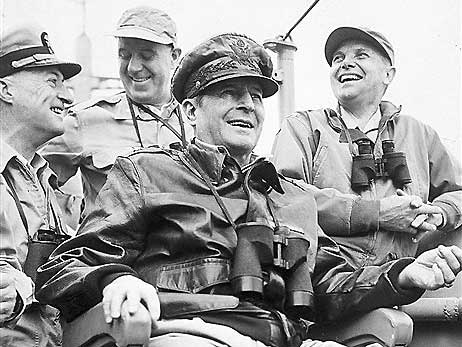
Oh what a lovely war. MacArthur and staff having a jolly good time during landings at Inchon. (1950)
People often forget that movies and television—supposedly "just harmless entertainment"— are also frequently drenched in devious pro-status quo propaganda. Thus while The New York Times, the WaPo, CBS, ABC, NBCm CNN, Fox News and the rest of the media may lie bald-facedly about US imperialist history, and many people are beginning to recognise that fact, Hollywood (which comprises films and television fare) is also part of the same mechanism to create political conformity on the basis of serious deformations of reality. Examining the thick fog of self-serving lies enveloping the history of US-Korea relations is indispensable to understand the conflict and enable the mind of free people to comprehend how we came to be on the very brink of the nuclear abyss.
The Korean War, like all major conflicts of interest to the US ruling circles, received the "Hollywood treatment" from the very beginning. The war, deviously labeled a "police action" by the US, took more than 50,000 American lives and millions of Koreans and Chinese. Some police action. It was fought under the blessing of a multinational UN force, implying, as usual, "world opinion" —or "the Free World"—condemning "communist aggression", a shopworn cliché even in the 1950s. In keeping with this manufactured high moral ground, Korea was the subject of scores of movies in the 1950s and later, almost all chiefly focused on the heroic deeds, inane concerns of the protagonists, and the inherent kindness, generosity, and technological awesomeness of United States military personnel and Americans in general. The Korean people—when they played any role at all in these melodramas—are simply compliant backdrop props. South Koreans (our guys) are helpless, terrified (of the Communists) and grateful for our being there; the North Koreans and Chinese are suitably faceless, ant-like fanatics, vicious enemies meriting no mercy.
Demonstrating the fact that American systemic propaganda easily spans liberals and conservatives, and that liberals have at best a very shallow understanding of the issues they get involved in (conservatives by definition see reality upside down), leading well known liberals like Humphrey Bogart were among the stars who had no trouble lending their talents to essentially anticommunist concoctions about Korea like Battle Circus (1954). After all, Bogart and his wife Betsy Bacall had been prominent in the formation of Hollywood's controversial Committee for the First Amendment, which included celebrities like John Huston, Gene Kelly, Groucho Marx, Danny Kaye and others willing to stand up to the HUAC in 1947. So, was Battle Circus a way for Bogart to re-certify his "American patriotism"? It's possible, even likely, considering the enormous pressures to conform and the cushy lives of Hollywood stars, not exactly the matrix where political martyrs or truly well-informed people are forged. In any case, Bogart himself provides much of the insight into his rationale for feeling comfortable making Battle Circus:
Bogart apparently felt the change in the air pretty quickly. Some reports say he lashed out at his fellow committee members on the plane home, while other suggest that many members of the brigade booked their own flights home early, out of embarrassment. Certainly, the right wing press—and in this climate, virtually everything save for the Daily Worker was leaning right—started attacking the unfriendly witnesses and their supporters in real time. After Congress voted to indict the Hollywood Ten for contempt, Bogart, allowed a statement to be syndicated to Hearst papers under the headline, “As Bogart Sees It Now,” which read in part:
I am not a Communist sympathizer. ... I went to Washington because I thought fellow Americans were being deprived of their Constitutional Rights, and for that that reason alone. That the trip was ill-advised, even foolish, I am very ready to admit. At the time it seemed the thing to do. I have absolutely no use for Communism nor for anyone who who serves that philosophy. I am an American. And very likely, like a good many of the rest of you, sometimes a foolish and impetuous American. (Bogie and the Blacklist, Karina Longworth, Slate, March 4, 2016)
The above is eloquent. Bogie in his virtual recantation equates anti-communism with Americanism, one of the oldest and most fraudulent and cynical equations in the US capitalist propaganda canon. (See American Brainwash: Guess what, Ma, capitalism is not Americanness!).
I offer below a sampler of Korean War movies and television artifacts. I trust the material speaks for itself. Well, with a little bit of nudging from outside.
—PG
II
CONTRARIAN REVIEWS
PATRICE GREANVILLE
1953 Battle Circus
Bogie (inadvertently) inaugurates the MASH franchise
1953-4 were good years for Korean War flicks. First, let's look at Battle Circus (1953), helmed by Richard Brooks and starring Humphrey Bogart and June Allyson, a reliable all-American Ms Goody-two-shoes, with a supporting cast featuring Keenan Wynn and Robert Keith.
The film is set in Korea during the Korean War. Bogart plays a surgeon and commander of Mobile Army Surgical Hospital (MASH) 8666 (shortened to "66" in the dialogue), with Allyson playing a newly arrived Army nurse (Lieutenant Ruth McGara). Despite their initial handicaps, their love flourishes against a background of war, enemy attacks, death and injury. At first, Ruth is a bumbling addition to the nurse corps, but attracts the attention of the unit's hard-drinking, no-nonsense chief surgeon Dr. and Major Jed Webbe (Humphrey Bogart). Jed cautions that he wants a "no strings" relationship and Ruth is warned by the other nurses of his womanizing ways. She sees that he is beloved by the unit, especially the resourceful Sergeant Orvil Statt (Keenan Wynn). According to Richard Brooks (in an interview filmed for the 1988 Bacall on Bogart documentary), Battle Circus was originally called MASH 66, a title rejected by MGM because the studio thought people would not understand the connection to a military hospital. The title of the film actually refers to the speed and ease with which a MASH unit, with its assemblage of tents, and portable equipment, can, like a circus, pick up stakes and move to where the action is. The MASH theme, as we know, would re-emerge 20 years later as a television sitcom. Obviously this plot, totally Americanocentric and focused on personal storylines of interest chiefly to American audiences, had little to say about the reasons for the Korean war or our own lethal meddling in the peninsula. (Main source: Wikipedia)
1951 The Steel Helmet
War is tough
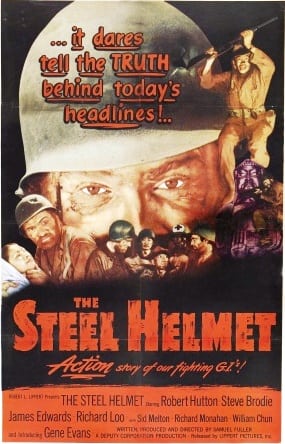 This melodrama by writer-director Sam Fuller (the first in the foul crop of Korea-themed movies), could have been about WW2 or WW1, as the story, except for being "localed" in Korea, focuses more on soldierly stuff than the real important historical backdrop. The commies of course are beyond the pale, and, ultimately, flaws and all, American fighting men prove to be the best the world has ever seen. Fuller, a "man's director" who himself had been a soldier, went on to make a second flick about this war, the very same year, 1951, popular among buffs of this genre, Fix bayonets! In his motion picture debut, James Dean appears briefly at the conclusion of the film. The Steel Helmet was produced by Lippert Studios, founded by a guy who owned about 120 theaters and was fed up with the rental fees he had to pay the big studios. Of some tangential redeeming interest: Racial integration of the U.S. military was going on during the Korean War and the movie is a parable about how all Americans needed to pull together and fight the Cold War. In sum, an ethnocentric film with little to say about the truth of the Korean conflict and with a standard dose of imperial propaganda and opportunistic message about race relations.
This melodrama by writer-director Sam Fuller (the first in the foul crop of Korea-themed movies), could have been about WW2 or WW1, as the story, except for being "localed" in Korea, focuses more on soldierly stuff than the real important historical backdrop. The commies of course are beyond the pale, and, ultimately, flaws and all, American fighting men prove to be the best the world has ever seen. Fuller, a "man's director" who himself had been a soldier, went on to make a second flick about this war, the very same year, 1951, popular among buffs of this genre, Fix bayonets! In his motion picture debut, James Dean appears briefly at the conclusion of the film. The Steel Helmet was produced by Lippert Studios, founded by a guy who owned about 120 theaters and was fed up with the rental fees he had to pay the big studios. Of some tangential redeeming interest: Racial integration of the U.S. military was going on during the Korean War and the movie is a parable about how all Americans needed to pull together and fight the Cold War. In sum, an ethnocentric film with little to say about the truth of the Korean conflict and with a standard dose of imperial propaganda and opportunistic message about race relations.
1952 Battle Zone
Love triangle gets hot in Korea
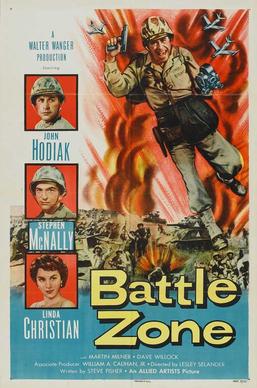 Battle Zone is a 1952 Korean War war film. Sequences of the film were shot at Camp Pendleton, California.
Battle Zone is a 1952 Korean War war film. Sequences of the film were shot at Camp Pendleton, California.
A rivalry develops between veteran of World War II M/Sgt Danny Young (John Hodiak) and Sgt. Mitch Turner (Stephen McNally) Marine combat photographers over the attentions of Jeanne (Linda Christian), a Red Cross nurse during the Korean War. Another love triangle between red-blooded guys in uniform and battlefield nurses, again, chiefly concerning Americans. OK, this mess happens to be taking place in Korea, so it's a war movie about Korea. Knowledge or insight about the conflict: zero. Propaganda value: the usual load. Very high, unapologetically high.
1954 Prisoner of War
Ronnie's Noble Sacrifice for the Sake of Victory and Decency in Korea
 Has Ronald Reagan ever been involved in any public enterprise not reeking of self-serving jingoistic nonsense? If you're looking for that don't look here because in this MGM turkey Ronnie sets new standards for service to the empire and its constant barrage of lies. The plotline says it all and you needn't sit there for 90 minutes to figure the ending. The story peg is supposedly based on Capt. Robert H. Wise, who lost 90 lbs in a North Korean POW camp. The man served as the film's technical advisor and said that the torture scenes in the movie were based on actual incidents. The rather ludicrous premise for the film is that an American officer (guess who) volunteers to be captured in order to investigate claims of abuse against American POWs in North Korean camps during the Korean War.
Has Ronald Reagan ever been involved in any public enterprise not reeking of self-serving jingoistic nonsense? If you're looking for that don't look here because in this MGM turkey Ronnie sets new standards for service to the empire and its constant barrage of lies. The plotline says it all and you needn't sit there for 90 minutes to figure the ending. The story peg is supposedly based on Capt. Robert H. Wise, who lost 90 lbs in a North Korean POW camp. The man served as the film's technical advisor and said that the torture scenes in the movie were based on actual incidents. The rather ludicrous premise for the film is that an American officer (guess who) volunteers to be captured in order to investigate claims of abuse against American POWs in North Korean camps during the Korean War.
For starters, torture when concerning food and pleasant accommodations is a very relative term, especially as understood by Americans, not to mention that, as this article makes clear the conditions in North Korea, thanks to American carpet-bombing and nonstop atrocities had put the entire population on the very edge of barest survival. Expecting to be housed and fed as if he'd been a tourist staying at the local Hilton is pure tendentious and intentionally dumb malarkey, the stuff that Ronnie Reagan thrived in. The Wiki notes that the "release of the film created a minor controversy. "The U.S. Army had assisted production and made edits in the script, but approval was abruptly reversed on the eve of release. The depiction of mistreatment of prisoners complicated the courts martial of POW collaborators that were proceeding at the time." The Wiki also adds that, in terms of historical accuracy, author Robert J. Lentz of the book Korean War Filmography: 91 English Language Features through 2000 states that the film was "undeniably overstated".[3]
Expect no truth about North Korea here neither.
1954 The Bridges at Toko-Ri
Glamorizing the genocide in North Korea
 The Bridges at Toko-Ri is a 1954 American war film about the Korean War and stars William Holden, Grace Kelly, Fredric March, Mickey Rooney, and Robert Strauss. The film, which was directed by Mark Robson, was produced by Paramount Pictures. Dennis Weaver and Earl Holliman make early screen roles in the motion picture.
The Bridges at Toko-Ri is a 1954 American war film about the Korean War and stars William Holden, Grace Kelly, Fredric March, Mickey Rooney, and Robert Strauss. The film, which was directed by Mark Robson, was produced by Paramount Pictures. Dennis Weaver and Earl Holliman make early screen roles in the motion picture.
The screenplay is based on the novel The Bridges at Toko-Ri by Pulitzer Prize winner James Michener, himself a onetime Navy officer.
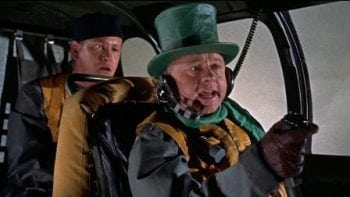
Forney (Mickey Roooney) flying his chopper to the rescue wearing his trademark (but non-regulation) Irish top hat.
 PLOT: Dashing US Navy Lieutenant Harry Brubaker (William Holden), a fighter-bomber pilot serving on a carrier off the coast of North Korea is given a mission to blast the bridges at Toko-Ri. Holden is not exactly enthused by the idea but his reluctance is not so much motivated by opposition to the war or communist sympathies, just a simple case of self-preservation. Why me? During the attack the commies, always humourless and rude to a fault, have the audacity to shoot Brubaker down behind enemy lines, prompting an attempt at rescue by the movie's two lovable characters, Chief Petty Officer (NAP) Mike Forney (Mickey Rooney) and Airman (NAC) Nestor Gamidge (Earl Holliman). The boys gallantly try their best to extract Brubaker from his tight spot but the malevolent commies again spoil the fun by blowing up the chopper (a Sikorsky HO3S-1) and killing Nestor. That now leaves Brubaker and Forney hugging a ditch, trying to hold off the enemy with pistols and Forney's and Gamidge's M1 carbines until they can be rescued, but both are killed by the North Korean and Red Chinese soldiers. Admiral Tarrant (Fredric March), angered by the news of Brubaker's death (whom he regarded as a son), demands an explanation from mission Commander Lee of why he attacked the second target. Lee defends his actions, noting that Brubaker was his pilot too, and that despite his loss, the mission was a success. Tarrant, realizing that Lee is correct, rhetorically asks, "Where do we get such men?" At this point there is not a dry eye in the house. Mission indeed accomplished.
PLOT: Dashing US Navy Lieutenant Harry Brubaker (William Holden), a fighter-bomber pilot serving on a carrier off the coast of North Korea is given a mission to blast the bridges at Toko-Ri. Holden is not exactly enthused by the idea but his reluctance is not so much motivated by opposition to the war or communist sympathies, just a simple case of self-preservation. Why me? During the attack the commies, always humourless and rude to a fault, have the audacity to shoot Brubaker down behind enemy lines, prompting an attempt at rescue by the movie's two lovable characters, Chief Petty Officer (NAP) Mike Forney (Mickey Rooney) and Airman (NAC) Nestor Gamidge (Earl Holliman). The boys gallantly try their best to extract Brubaker from his tight spot but the malevolent commies again spoil the fun by blowing up the chopper (a Sikorsky HO3S-1) and killing Nestor. That now leaves Brubaker and Forney hugging a ditch, trying to hold off the enemy with pistols and Forney's and Gamidge's M1 carbines until they can be rescued, but both are killed by the North Korean and Red Chinese soldiers. Admiral Tarrant (Fredric March), angered by the news of Brubaker's death (whom he regarded as a son), demands an explanation from mission Commander Lee of why he attacked the second target. Lee defends his actions, noting that Brubaker was his pilot too, and that despite his loss, the mission was a success. Tarrant, realizing that Lee is correct, rhetorically asks, "Where do we get such men?" At this point there is not a dry eye in the house. Mission indeed accomplished.
CODA: When I was a young man—a teen— and suitably impressionable I loved this film. I had then (like many young males) a fascination with militaria, especially jet planes, and this movie was rich in that, including the legendary Sabre jets. So I felt for Lt Brubaker and his pals being cornered in that ditch, thousands of miles from home. Man, was I was wrong. What a sucker. Even conceding that Brubaker and his mates were also victims of the same system whose sheer hugeness blinded them to the obvious, I should have seen through the imposture. But I didn't. So don't feel bad if you didn't either. You are in the hands of expert manipulators.
1957 Battle Hymn
Pious Rock Hudson battling commies and doing orphan rescue on the side
 We sum up this film as a straight highly manipulative propaganda artifact from beginning to end, calculated to touch all the right sentimental buttons in decent people. Heartthrob Rock Hudson is recruited to do his part for the empire and the national religion, "free enterprise" at all costs. Indeed, in Hollywood (and Television) history, few actors have ever escaped that kind of duty, not that they were even remotely aware of what they were doing.
We sum up this film as a straight highly manipulative propaganda artifact from beginning to end, calculated to touch all the right sentimental buttons in decent people. Heartthrob Rock Hudson is recruited to do his part for the empire and the national religion, "free enterprise" at all costs. Indeed, in Hollywood (and Television) history, few actors have ever escaped that kind of duty, not that they were even remotely aware of what they were doing.
Battle Hymn (aka By Faith I Fly) is a 1957 Technicolor war film starring Rock Hudsonas Colonel Dean E. Hess, a real-life United States Air Force fighter pilot in the Korean War. Hess's autobiography of the same name was published concurrently with the release of the film. He donated his profits from the film and the book to a network of orphanages he helped to establish. The film was directed by Douglas Sirk and produced by Ross Hunter and filmed in CinemaScope. Prior to the attack on Pearl Harbor, Dean Hess (Rock Hudson) was a minister in Ohio. The attack prompts him to become a fighter pilot. Hess had accidentally dropped a bomb on an orphanage in Germany during World War II, killing 37 orphans. At the start of the Korean War, Hess volunteers to return to the cockpit and is assigned as the senior USAF advisor/Instructor Pilot to the Republic of Korea Air Force, flying F-51D Mustangs. As Hess and his cadre of USAF instructors train the South Korean pilots, several orphaned war refugees gather at the base. He solicits the aid of two Korean adults, En Soon Yang (Anna Kashfi) and Lun Wa (Philip Ahn), and establishes a shelter for the orphans. When the Communists begin an offensive in the area, Hess evacuates the orphans on foot and then later, after much struggle with higher headquarters, obtains an airlift of USAF cargo aircraft to evacuate them to the island of Cheju, where a more permanent orphanage is established.
1972—1983 Network television
MASH: Liberal propaganda apotheosis
MASH is a colossal case of a sacred bovine in US culture, almost universally acclaimed, so it may seem foolish, even reckless, to try tilting at it, but that's what we need to do to peel away the complacency reinforcing the official narrative about these international tragedies. Let us begin by quoting the Wiki:
" 
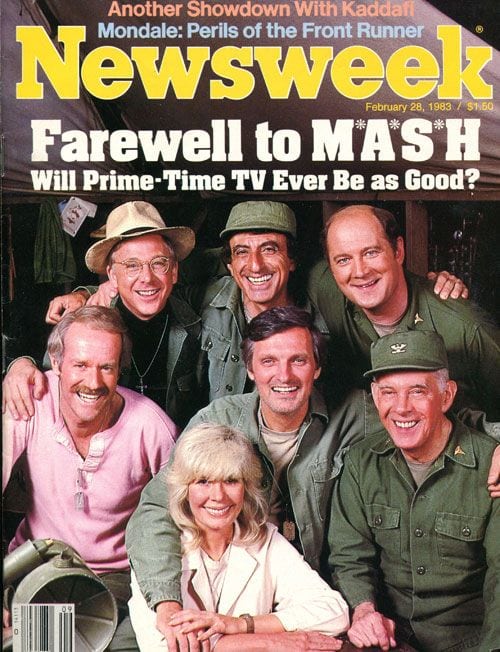 M*A*S*H is a 1972–1983 American television series developed by Larry Gelbart, adapted from the 1970 feature film MASH (which was itself based on the 1968 novel MASH: A Novel About Three Army Doctors, by Richard Hooker). The series, which was produced with 20th Century Fox Television for CBS, follows a team of doctors and support staff stationed at the "4077th Mobile Army Surgical Hospital" in Uijeongbu, South Korea during the Korean War. The television series is the best-known version of the M*A*S*H works, and one of the highest-rated shows in U.S. television history. M*A*S*H aired weekly on CBS, with most episodes being a half-hour (22 minutes) in length. The series is usually categorized as a situation comedy, though it is also described as a "dark comedy" or a "dramedy" because of the dramatic subject material often presented..."
M*A*S*H is a 1972–1983 American television series developed by Larry Gelbart, adapted from the 1970 feature film MASH (which was itself based on the 1968 novel MASH: A Novel About Three Army Doctors, by Richard Hooker). The series, which was produced with 20th Century Fox Television for CBS, follows a team of doctors and support staff stationed at the "4077th Mobile Army Surgical Hospital" in Uijeongbu, South Korea during the Korean War. The television series is the best-known version of the M*A*S*H works, and one of the highest-rated shows in U.S. television history. M*A*S*H aired weekly on CBS, with most episodes being a half-hour (22 minutes) in length. The series is usually categorized as a situation comedy, though it is also described as a "dark comedy" or a "dramedy" because of the dramatic subject material often presented..."
OK, fine. We get it. This is a much admired and beloved tv series that apparently everyone in America embraces unquestioningly (the list of things Americans embrace without question is long and getting longer by the day). Personally, I think this universal approval may be a case of groupthink, liberal style. Why, let me play the Grinch, once again.
MASH is cowardly. MASH is ostensibly (wink wink) about the Korean war, but it aired during the Vietnam War since the producers quite characteristically wanted to avoid controversy (and risk the ratings). Amiability in the service of the tyranny of conformity, especially when Mammon is involved, is always a strong point with affluent liberals.
MASH avoids the obvious. In its long run the series never asked some basic common sense questions. Like, what on earth gave the Americans the right to be in Korea? In fact why were these military doctors in Korea patching up so many US and allied soldiers? There's never any word about what caused the conflict, or what role the US played in this mess, except for banal and tangential allusions to the heartlessness and perfidy of the communists, the terrible cost of war, or similar mawkish mumbo jumbo long accepted as the official and irrefutable version of events about Korea. MASH never wishes to upset the apple cart, or offend anyone in the great American audience (especially the establishment) so everyone involved goes around doing somersaults to escape the pervasive banality and actual timidity of the plotlines (more on this later) while while in pursuit of the all-consuming high ratings. Meanwhile, to alleviate the conscience of the ethical thinkers on the team, fair doses of liberal platitudes and pabulums are administered all around, as a bow to the undeniable magnitude of the suffering.
MASH trivializes (and exploits) a huge tragedy. Frat humour, sexcapades, and endless shenanigans punctuate MASH, even if toward the middle of the run the series began to change the mix, going from a sitcom with occasional dramatic moments, to a drama interspersed with frequent comic "relief". None of this saves the show from its signal evasions and significant collaboration in the great and perennial effort to hide the nature of US imperialist crimes. Which leads us to our next charge.
MASH whitewashes the US "right" to intervene anywhere. By hiding the actual viciousness of the Korean war and the US role in it, and depicting Americans as a bunch of kind, largely innocent, good-natured do-gooders in a foreign land, MASH reinforces the notion that even if Americans turn up in a country uninvited, they're surely going to be a force for the good of everyone, a rather dubious idea to put it mildly, especially if we ask your Syrian, Libyan or Iraqi man in the street.
MASH never says the US military brass and the politicians are criminals. At most, they're just bumbling idiots worthy of a laugh...and jejune derision, the smirking of the powerless, leaving business as usual to go on undisturbed.
ethical thinkers on the team, fair doses of liberal platitudes and pabulums are administered all around, as a bow to the undeniable magnitude of the suffering.

